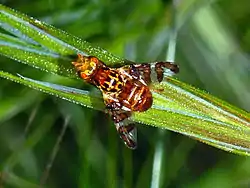Goniglossum wiedemanni
Goniglossum wiedermanni is a species of tephritid or fruit flies in the family Tephritidae.
| Goniglossum wiedemanni | |
|---|---|
 | |
| Goniglossum wiedermanni | |
| Scientific classification | |
| Kingdom: | |
| Phylum: | |
| Class: | |
| Order: | |
| Family: | |
| Subfamily: | |
| Genus: | Goniglossum |
| Species: | G. wiedermanni |
| Binomial name | |
| Goniglossum wiedermanni (Meigen, 1826) | |
| Synonyms | |
| |
Description
Goniglossum wiedermanni can reach a body length of 3.5–5.1 millimetres (0.14–0.20 in) in male, of 4.5–5.5 millimetres (0.18–0.22 in) in females. Wings can reach a length of 2.8–3.8 millimetres (0.11–0.15 in) in males, of 3.6–4.5 millimetres (0.14–0.18 in).[5] These fruit flies have an elongate head, with a long proboscis. Thorax is yellowish with dark brown markings. Scutellum has three usually isolated black spots. Abdomen is yellow to reddish-brown, without black bands, but with golden-yellow margins of tergites 2–4 in male, 2–5 in female. The last tergite is bare and shiny. Wings are hyaline, with brown bands.[5][6]
Distribution
This species is present in Austria, Belgium, the British Isles, France, Germany, Hungary, Italy, Russia, Spain, Switzerland, and in the Near East.[7]
Biology
Adults can be seen from May to August, with a peak period in July.[8][9] They feed on nectar of Bryonia dioica.
This species is host-specific to white bryony (Bryonia alba, Bryonia dioica) (Cucurbitaceae), in which berries larvae develop.[6][5]
References
| Wikispecies has information related to Goniglossum wiedemanni. |
| Wikimedia Commons has media related to Goniglossum wiedemanni. |
- Smith, James J.; Bush, Guy L. (2001). "Chapter 9: Phylogeny of the subtribe Carpomyina (Trypetinae), emphasizing relationships of the genus Rhagoletis". In Aluja, Martin; Norrbom, Allen (eds.). Fruit Flies (Tephritidae): Phylogeny and Evolution of Behavior. CRC Press. pp. 187–217. ISBN 978-0849312755. Retrieved 1 June 2015.
- Nomen.at
- Biolib
- Bisby F.A., Roskov Y.R., Orrell T.M., Nicolson D., Paglinawan L.E., Bailly N., Kirk P.M., Bourgoin T., Baillargeon G., Ouvrard D. Catalogue of life
- Plazi Treatment Bank
- The Diptera Site - Keys for Carpomya
- Fauna europaea
- Nature Spot
- iNaturalist